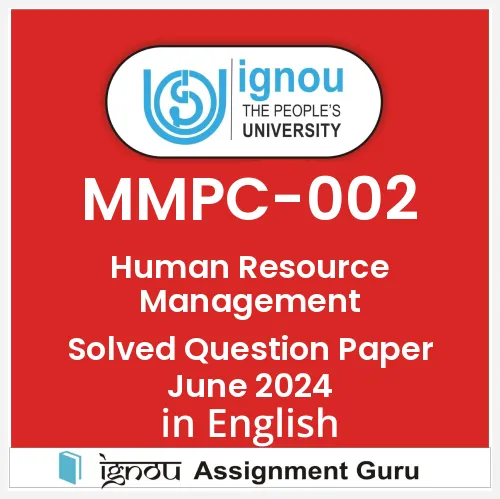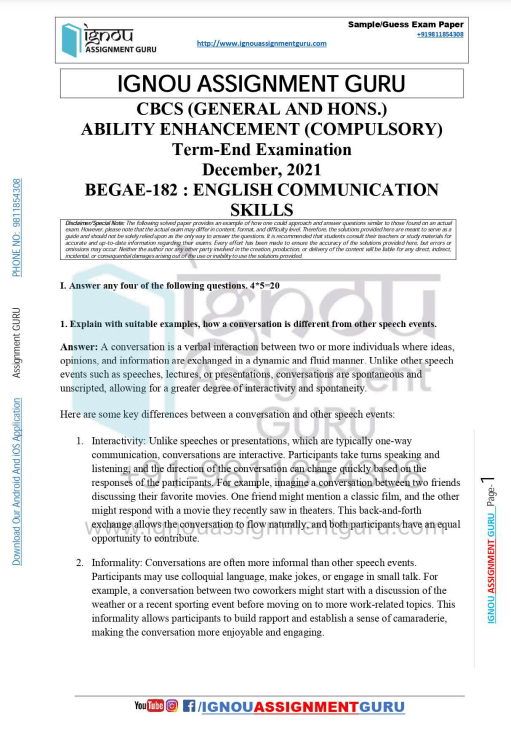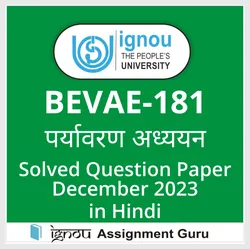- Your cart is empty
- Continue Shopping
MMPC-001 MANAGEMENT FUNCTIONS AND ORGANISATIOINAL PROCESSES Solved Question Paper June 2024
₹20.00Current price is: ₹20.00. Original price was: ₹100.00.
MMPC-001 MANAGEMENT FUNCTIONS AND ORGANISATIOINAL PROCESSES
Solved Question Paper June 2024
MANAGEMENT FUNCTIONS AND ORGANISATIOINAL PROCESSES
Course Code: MMPC-001
MMPC-001 MANAGEMENT FUNCTIONS AND ORGANISATIOINAL PROCESSES Solved Question Paper June 2024
MANAGEMENT FUNCTIONS AND ORGANISATIOINAL PROCESSES
Course Code: MMPC-001
| Title Name | MMPC-001 Solved Question Paper June 2024 |
| University | IGNOU |
| Service Type | Solved Question Paper (Soft copy/PDF) |
| Course | MBA / Management |
| Language | English |
| Year | June 2024 |
| Course Code | MMPC-001 |
| Product | Solved Question Paper (IGNOU) |
1. Briefly describe and discuss different roles a
manager has to perform in an organization and
the dynamics involved with reference to the
present day context.
2. Describe and discuss the approaches to
organizing and analyzing work and their
relevance with examples.
3. What is staffing ? Discuss its importance.
Describe and discuss various sources of
recruitment and their advantages and
disadvantages.
4. How does communication play an important
role in the organization ? Discuss barriers to
effective communication and how can they be
minimized.
5. Write short notes on any three of the following :
(a) Organizational culture
(b) Turnaround management
(c) Line and staff
[ 3 ] MMPC–001
P. T. O.
(d) Brainstorming
(e) Managerial grid theory
Section—B
6. Read the following case and answer the
questions given at the end of the case :
Modern Bank Limited was established in 1938
by Vasudev Mudaliar as a private bank. The
bank grew to become a 100 crore business by
1944 and a 500 crore business by 1960.
Vasudev Mudaliar was succeeded in the
business by his sons. In 1974, an investor,
Sudhakar Gupta, bought 51% equity in the
bank and assumed charge as chairman. The
bank gradually expanded in the four southern
states and grew to be a business worth 3,200
crore by 1985. In 1987, Sudhakar Gupta
brought in Arvind Jain, a young MBA graduate,
as the MD of the bank. Arvind Jain focused his
energies on building the brand of the bank
among the traditional segments and
[ 4 ] MMPC–001
simultaneously focused on building brand
equity among the middle class. During this
period the bank recorded continuous business
growth and by 1997, the bank’s total business
stood at 12,000 crores. Arvind Jain was a fiery
young man who essentially believed in
turnaround performance. His style of
leadership was autocratic and he believed that
people around him should be committed to
executing his orders rather than wasting time
on debates and discussions. He formed a core
group of top executives to strategize and
monitor the implementation of action plans.
Being a traditional bank where hierarchy and
authority were respected, it was not long before
everyone adjusted to the new style of
functioning. Everybody from the branch offices,
regional offices, and the head office, religiously
followed the orders of the top management. The
result was a stupendous success. The bank
[ 5 ] MMPC–001
P. T. O.
became a force to reckon with among the
private sector bank in southern India. Arvind
Jain emphasized the following aspects :
• Recruiting top-notch professionals reengineering the corporate brand of the
bank emphasizing marketing and business
development.
• A top-down approach in the decisionmaking process.
• Adoption of technology for modernizing
business operations. Along with the
positive developments were a few negative
aspects.
• Centralization of the bank’s functioning.
• Formation of a coterie which wielded
power in the bank.
• Emphasis on performance at any cost
rather than on means.
• Frustration and disillusionment of the
employees at large Parallel with these
developments, there were other
developments too in the bank.
[ 6 ] MMPC–001
Differences arose between the promoter
Sudhakar Gupta and the MD Arvind Jain,
which eventually led to the resignation and exit
of the latter from the bank. A few of his faithful
followers too exited from the bank. The
chairman, in consultation with the board,
appointed a senior banking professional, Manoj
Pillai, from an established public sector bank,
as the MD of Modern Bank. On assuming
charge, Manoj Pillai reshuffled the top
management and set up a new team at the
corporate office. It was his belief that systems
and procedures should take precedence over
individuals in the bank, and that after goals are
set, executive should be given freedom to
perform. A few hallmarks of his leadership and
management approach in the bank were as
follows :
• Emphasis on streamlining systems and
procedures
[ 7 ] MMPC–001
P. T. O.
• Nurturing employees to strictly adhere to
laid-down norms /system.
• Training of existing employees in core
areas such as credit, audit etc. recruitment
of young professionals, i. e., MBA, M.Com.,
etc as management trainees and their
induction into the bank to bring in fresh
blood and enthusiasm.
• Strengthening the training system for
undertaking training and induction
responsibilities.
• Posting of successful line personnel as
faculty in Staff Training Colleges to drive
home the importance of training to the
employees of the bank.
• Continuing the technology upgradation
processes undertaken during earlier
review. However, the employees of the
bank, especially the top and middle
management, who were used to following
the instructions of the central command
[ 8 ] MMPC–001
and carrying out the decisions of
centralized decision-making could not
adjust to the new leadership approach. The
top executives started perceiving the new
leader as weak, due to lack of the charisma
and strong drive that they had seen in the
earlier leader. Further, the emphasis on reengineering the systems led to stagnation
of product innovation and during the three
years Manoj Pillai was with the bank, no
product could be launched. The bank
slowly lost its market share and recorded a
negative growth during the period
1997-2000. There was an interesting
development in 1999, when the promoter
offloaded a minus stake to a multinational
bank. The changed business interest of the
promoter led to further offloading of stake
in favour of the multinational bank. As a
result the majority stake in the bank stood
transferred to the multinational bank. The
[ 9 ] MMPC–001
P. T. O.
new management undertook a series of
measures to re-engineer and redefine the
brand and image of the bank. Some of the
salient features of these measures were :
• Upgrading the technology of the bank.
• Tearing up the bank for various technology
initiatives such as core banking solutions,
Internet banking, call centre and help
desk, etc.
• Recruitment of a new breed of
professionals at all levels and in all
functional areas to cater to the needs of the
bank.
• Strict implementation of the performance
planning and measurement approaches.
• Implementation of Cost To Company (CTC)
approach for all the middle and top
management officials of the bank.
• Voluntary Retirement Scheme (VRS) for
employees found to be lacking in the new
set of competence.
[ 10 ] MMPC–001
• Massive exercise of re-branding and reengineering the product portfolio of the
bank.
• Creation of a core team of young
professionals to continuously work on rebranding and product re-engineering.
• Improving the learning infrastructure by
networking the IT infrastructure with the
existing training infrastructure to leverage
the advantages.
During the initial transformation period, the
old genre of employees were frustrated by the
higher compensation given to the new recruits
as well as the importance accorded to them as
against the existing employees. This led to the
exodus of a large number of employees
through the voluntary retirement scheme. The
remaining employees were in a state of
confusion about the direction the bank was
heading in. In the meantime, the new
management recruited an MD, Vikrant
Advani, a senior banking professional with
[ 11 ] MMPC–001
P. T. O.
over 20 years of experience, to lead the bank,
along with a new set of initiatives. After
assuming charge, Vikrant Advani made it a
point to personally interact with all senior
executives. He communicated with all
employees about the transformation process
and the steps undertaken by the bank for the
purpose. As a step towards implementing the
knowledge management process in the bank,
the training department launched a whole set
of initiatives with the help of the IT
department as given below :
• Setting-up of corporate Intranet for the
bank with built-in features such as bulletin
boards, discussion and chat rooms, etc.
• Integrating the e-learning software with
the Intranet to provide learning inputs to
the employees.
• Identifying resource persons areawise and
making them available online to
disseminate learning across organization.
[ 12 ] MMPC–001
• Collecting the critical experience of
employees in various functional areas and
presenting them as case studies for
employees to learn.
• Providing all the information and circulars
related to various systems and procedures
of the bank online to empower the
employees with information.
• Tying up with learning content providers
for continuously updating the learning
content.
Questions :
(a) Identify the core issues in the case.
(b) If you are the manager what measures
would you adopt to improve the processes
in the bank ?











Reviews
There are no reviews yet.